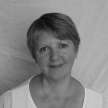Forget goal-setting. This works better.
Goals often come from the head not the heart, and are all about the destination. Learn to love the journey instead
Every year, I give myself a dream day.
If the weather is bad, I might stay in bed, with my journal and some good music playing. If it’s a nice day, I might go for a long, solo walk to think and dream.
Where I live — on the Kent coast, facing France — there are footpaths that have been used since before the Roman emperor Julius Caesar landed on the beach here with his troops. There is a Roman fort and amphitheatre near my home, plus three castles built by Henry VIII. I often walk across a former World War I airfield, or along a bay littered with the bones of wrecked ships at low tide.
So it’s a good place to time-travel.
Because that’s what I do, in my future dreaming. I start by thinking about what I love, what lights me up, who and what excites and energises me. I also think about the activities that tend to make time disappear altogether, because I’m in flow, indistractible and aware of little else.
Once I feel connected with the people, places and activities I most enjoy, I step gently into the future. No specific time or date. I just let the days, weeks, months, years unfold until I’m living my best life.
If I’m in bed, I lie down with my eyes closed and float out of my body until I’m high above the world and utterly weightless, then glide forward in time. If I’m walking, I’ll just imagine that each step is a week, a month, a year until it feels like I’ve arrived at the right point in the future.
In this future life, I have everything I need.
Time. Space. Talent. Skills. Luck. Support. Health. Wealth. Any barriers in my way have dissolved, and everything has worked out perfectly. And on my dream day, I get to look around this glittering future and see what I’ve built.
I take a walk around my home, looking at the decor and furnishings, the books on the shelves, the art on the walls, the clothes hanging in the wardrobe and any other details I’m curious about. I look at my workspace, and the body of work I’ve created.
I see what I eat, how I stay fit and well. Who I’m hanging out with: my friends, my team, my tribe. What a typical working day looks like, for me. And what I do for fun.
Sometimes I’ll meet my future self.
(Though in truth, she never looks much like me.) Sometimes she has advice, or a message. Sometimes she just grabs me by the hand and somehow imparts memories of great holidays, exciting trips, fun days with friends, major life events.
The experience is different every time I do it. Sometimes it’s fuzzy on detail, sometimes it’s hyper-specific. But there are always common themes.
Writing is always a part of it, for me. My home is warm, comfortable but also uncluttered. It’s rarely in a city, these days. Year after year, it gets smaller too as I yearn more for simplicity, space and time than for stuff.
Even though I am older, I am always fitter, healthier. And although I have plenty of time alone, I’m also surrounded by love and laughter, with creative and interesting friends.
When I’ve seen enough, I leave this ideal future.
I travel back towards the present, to a time about five years from now.
I’m already well on my way to the future I imagined, so I look at the changes I’ve made to my work, my home, my community, my health, my life. The skills and knowledge I’ve gained, the new habits and routines I’ve created, the work I’ve made. And the changes yet to come.
Once that is clear, I come even closer to the present, a year from my dream day. I’m progressing towards becoming the person I saw five years into the future, and I can see the changes I’ve made, over the year, to get there.
Then I return to the here and now.
This is where the journal comes in. I write down all the action steps, the systems, routines and habits I need to establish in order to make what I saw a reality over the next 12 months. I write milestones I want to pass, and list small, do-able actions for the next month and quarter.
Then I’ll consider what was going on, deep in my future dreaming. What does it tell me about my present life? What am I most longing for? And how can I get some of that into my life right now?
Usually there are elements that are accessible: dinners with friends, a beach holiday, long walks in the woods, going to more art and book events are all things that came out of my last dream day, for instance.
I also consider who I need to become, to bring that future closer. Do I need new skills or knowledge? Habits or routines? What do I need to do more of? And less?
I’m drawing a map, towards the future I imagined.
By the end of it, I usually have more clarity about the direction I want to go in, the tiny course corrections I want to make. I’m also much more connected emotionally to the outcome.
Year after year in January, I made grand lists of goals, most of them things I felt I should want or fixing what I felt was wrong with me. And if I’m honest, I rarely did much about them.
They were too big, too vague, too abstract. I wanted to earn £100k then £250k. I wanted to get fitter, write a new book. But as none of this was about my day-today behaviour, I never got there.
So I left it, thinking I’d tackle it next week, next month, later. And eventually I’d leave off thinking about my list of lofty ambitions at all, because no one loves feeling like a failure.
This is the trouble with goals.
They’re all about the end result, not the process or journey. If we focus only on goals, we start to believe that we can only be happy/confident/successful once we’ve lost weight/signed a record deal/earned a six-figure sum/finished the book/won the big award.
Then we perhaps allow a brief moment of celebration and satisfaction before setting new, even bigger goals. And the striving starts all over again. We’re often chasing external measures of success that don’t even fit the life we want to live, the work we want to make: they just look good on social media, they sound impressive, or they’re about the expectations of others (our families, our friends, our culture).
Future dreaming helps you plan from the heart, not the head.
It gives you clarity on the lifestyle you want. The people you long to connect with. And the work you really want to make.
The time-travel also tells you what you really want, here and now. Those stop-offs at the five-year mark then at a year from today help you see the small actions you can take now, to get you there.
It then becomes more about process: about repeating habits, routines and systems. And about enjoying the journey, as well as focussing on the destination.
If your goal is to write a book, don’t just focus on finishing it, on getting an agent, or a publishing contract. Focus on small, regular wins such as writing, every day or week. Make it fun. Make it sustainable. Make it part of who you are, rather than a goal to be attained.
Not writing a book, year after year, felt like a colossal failure to me. But not writing for a day or two? That’s not such a big deal. And it’s easily remedied if I just go to my desk and begin again.
Planning your year is a four-step process
Each part is important, and helps you get where you want to be with more ease and grace. More fun.
1. Review the past year, and see what can be learned from it.
2. Assess the present, and think about tiny changes you might make to improve all areas of your life, just a little.
3. Indulge in some future dreaming.
4. Put systems, habits and routines in place to get you where you want to be.
You can find your own questions and route for this. But I walk you through this entire process in Your Next Year, a 44-page workbook that comes in the form of a printable PDF you can use, year after year. You can buy that here, for £14.99. It's a good way to plot out your best year ever.
About the Creator
Sheryl Garratt
Sheryl Garratt is a former editor of The Face and Observer magazines, and has written professionally for more than 30 years. She is also a coach working with creatives of all kinds. Find her at thecreativelife.net
Enjoyed the story? Support the Creator.
Subscribe for free to receive all their stories in your feed. You could also pledge your support or give them a one-off tip, letting them know you appreciate their work.







Comments
There are no comments for this story
Be the first to respond and start the conversation.